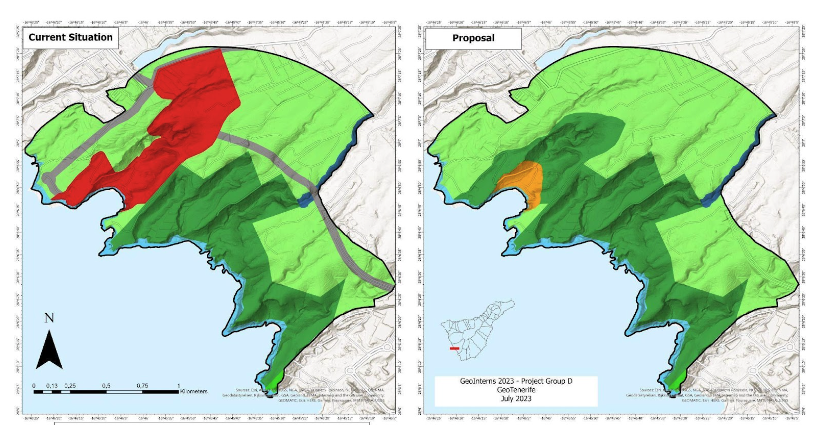What did we Research?
The students and leading local experts taking part in our scientific programmes ‘GeoIntern’ and ‘Marine Science Camp’ of 2022 and 2023 researched and collected data on the following subjects in the El Puertito area. As we continue to research the impact of the potential Cuna del Alma project on El Puertito and residents we will update this page with our new findings.
Hover on one of the boxes to read a summary about the subject and learn where to find out more information.
Geology
The area of Puertito de Adeje has incredible geological formations showing a unique and accessible record of 300,000 years of Tenerife’s oldest highly explosive eruptions in geological deposits called ‘ignimbrites’. Preserving this record is important to define how many highly explosive “Plinian” events Tenerife has experienced to inform emergency management plans for Tenerife’s residents and tourists. To learn more about the geology of El Puertito, see our interactive map below.
Over the past three years, our GeoInterns have been working with Dr Richard Brown of Durham University to uncover evidence of more explosive eruptions than the 20 already on record. This research in Tenerife is also helping to build volcanic resilience globally. Read more about why preserving the ignimbrites is important in the geology section of our report here.
Resident Opinion
When work on the Cuna del Alma project began in May 2022 weeks of resident and environmental group protests began, which put pressure on the authorities to investigate the project’s impact on the environment. Residents express indignation that land that has been expropriated for 12,000 euros will be redeveloped into a luxury development with villas costing up to 3 Million euros each. To learn more watch our YouTube playlist on how residents feel about the project.
Coming Soon: Coastal Habitats
Coming soon: The Coastal environment of El Puertito and its unique habitats are under threat from the promoter’s plans to redesign the beach and cover it with sand. This area will be the focus of our research in 2024. For updates on our research, follow us on social media.
Coming Soon: Birds
The local birdlife is a mixture of seabirds and land birds such as the Common Tern, Common Kestrel, and Little Egret. Some of the Bird species present here use the site as migration and breeding grounds, making the area of significant importance to these species. To learn more about how our proposal to designate El Puertito as protected land would protect these species, please come back soon to read the section coming to our report here.
Legal framework
The land protection of El Puertito was recently changed to reclassify the El Puertito from “Rustic”, a protected land classification which prevents construction, to “Urbanisable”, earmarking the area for development. Despite El Puertito’s natural values and proximity to the La Caleta Site of Scientific Interest and the Teno-Rasca Marine Special Area of Conservation. The land was previously identified as ecologically important but then reclassified to build another large-scale tourist development on the disappearing natural coast of Southern Tenerife. To learn more about Tenerife’s environmental legislation read the Territorial Planning section of our report here.
Greenwashing
Greenwashing is the presenting of false claims about the environmental friendliness of a product, service, or project to appeal to customers. A leading expert has analysed the Cuna del Alma website for potential greenwashing practices; Whilst the project claims it will produce 750 jobs, revive the natural environment, and protect biodiversity, what is the reality for the residents and environment? To learn how some claims made on the website misrepresent the development in El Puertito, read the Greenwashing section of our report here.
Natura Network
Natura 2000 is an ecological network of protected areas in the EU that protects biodiversity. The marine strip of Teno-Rasca, a Natura 2000 site, protects marine species in the sea of South Tenerife. This high level of protection is based on the marine biodiversity, with various dolphins and turtle species like the loggerhead turtle. Moreover, the diversity of the Teno-Rasca Special Area of Conservation (SAC) has been recognized as a Whale Heritage site by the World Cetacean Alliance (WCA).
This Special Area of Conservation is threatened by the construction of the Cuna del Alma project; to find out more, read our report.
Coming Soon: Natural Resources and Infrastructure
The massive numbers of tourists visiting Tenerife have caused long-term impacts of resident dissatisfaction, degrading hotels in areas of natural beauty, water scarcity, solid waste mismanagement, and a high dependence on overseas suppliers.
Through our research, we will be analysing the potential impact of another hotel complex on the natural resources and infrastructure of Tenerife.
For updates on our research, follow us on social media.
Vegetation and soil
Puertito de Adeje is one of the few stretches of the southwest coast that is largely unchanged and a haven for rare native plants, especially the tabaibal-cardonal mature community of coastal scrub. Some of these specimens are over 100 years old and cannot simply be replanted elsewhere and the loss of these plants would impact a landscape Tenerife’s residents have been able to enjoy for generations. To learn more about the vegetation use our interactive map below and to learn why preserving the tabaibal-cardinal community is important read the Vegetation and Soil section in our report here.
Habitats of Community Interest
According to the EU Habitat Directive, habitats of community interest are natural areas of significant importance for biodiversity conservation in the European Union. In the Puertito area, there are significant Macaronesian habitats of community interest that could be destroyed. To learn about the habitats of community interest in El Puertito, read our report here.
Marine Life
Our December 2023 Research Campaign in collaboration with the Oceanographic Institute and with our Marine Science students researched the marine life present in this area, using underwater drone flights, which could be endangered by the construction of a hotel complex. The seagrass (Cymodocea nodosa) observed in the marine environment of El Puertito is a vital marine ecosystem in sandy bottoms; Seagrass meadows serve as a nursery habitat for fishes and invertebrates. However, the marine environment observed in El Puertito has started to deteriorate due to water contamination. To learn more about the native marine species, invasive algae, and the source of effluent along Southern Tenerife, please read our report here.
Coming soon: Archeological heritage
The importance of preserving the culture and heritage of the Guanche, the indigenous people of Tenerife, has only recently begun to be officially recognised. To restore and maintain the legacy of the Guanche, examples of their language, culture, and life should be protected. An archaeological study in the Puertito de Adeje area discovered cave markings and determined the site has “great potential”, however, the site was damaged during the Cuna del Alma construction. The Tenerife Heritage Office of Tenerife has confirmed the project had multiple failures to report this archaeological evidence. To learn more read our report here.
Coming Soon: Is the mass tourism model in Tenerife broken?
The southern strip of Tenerife has more 5* hotels per km2 than Madrid or Barcelona. Visitor numbers are booming. But unemployment and inequality are among the worst in Spain. The current tourism model favours international developers with a record return on investment, unrivalled occupancy rates, whilst paying just 4% tax. However, these large luxury developments can destroy natural habitats; put pressure on limited natural resources and infrastructure, create low-quality jobs not favoured by locals leading to ever higher immigration rates, and starve local businesses and enterprise out of the market. Is the current tourism model broken? Full report coming soon.
Our Interactive Results
We aim to raise awareness about the challenges this area is facing and to inspire collective efforts towards its preservation because Puertito de Adeje is of significant interest to scientists and residents. It has unique bird habitats in the ravines, native plant communities, and evidence of ignimbrites which bear unique testimony of Tenerife’s eruptive history. We believe this area should be protected and propose that the La Caleta Site of Scientific Interest be extended to include El Puertito.
Development timeline
-
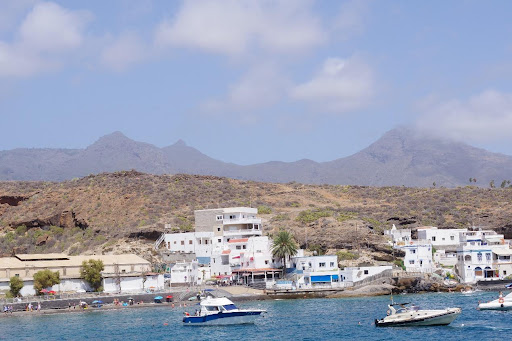
Puertito de Adeje (El Puertito) is a small coastal village in the south of Tenerife located within the municipality of Adeje. This small coastal area is one of the few largely untouched natural spaces found in the south of the island.
However, this land has been used for generations: The Guanche, the indigenous people of Tenerife adapted to the island’s unique environment and climate and evidence of Guanche life in El Puertito was found during a protest of the Cuna del Alma project by a Tenerife resident. Furthermore, a shrub plant called Euphorbia Balsamifera is found in the sweet tabaibal plant community of El Puertito, this species was used as chewing gum by the Gunache which is a continued tradition today in the Canary Islands. Examples of the Guanche language, culture, and life should be preserved to restore and maintain the Guanache’s legacy in Tenerife.
Photo credit MarineSciCamp (2023)
-
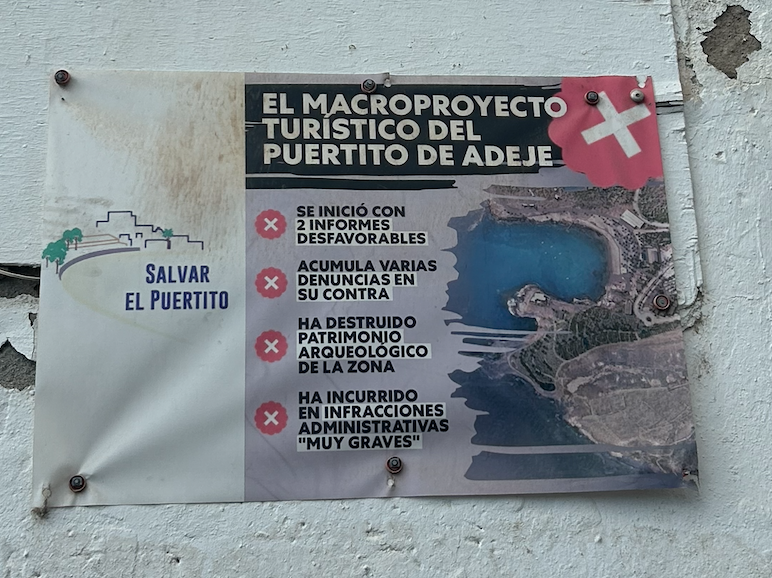
After the global financial crisis in 2008, policies in Tenerife promoted foreign investment and granted foreign investors highly advantageous tax and financial repatriation terms. Land had become a commodity to service the tourism industry and not for local people to enjoy.
Reclassification of land into less protected classes has led to many developments popping up on the south coast of Tenerife; The level of protection at Puertito de Adeje was downgraded from “Rustic” to “Land Suitable for Planned Urban Development”, thus, allowing for the Cuna del Alma project to be proposed.
Similar tourist projects have negatively impacted the ecosystem and residents by turning the coast into a commodity for tourists and investors while alienating locals: The deterioration of dune habitats in Tenerife due to construction, lack of quality employment for residents, and the starving income from the local economy.
-
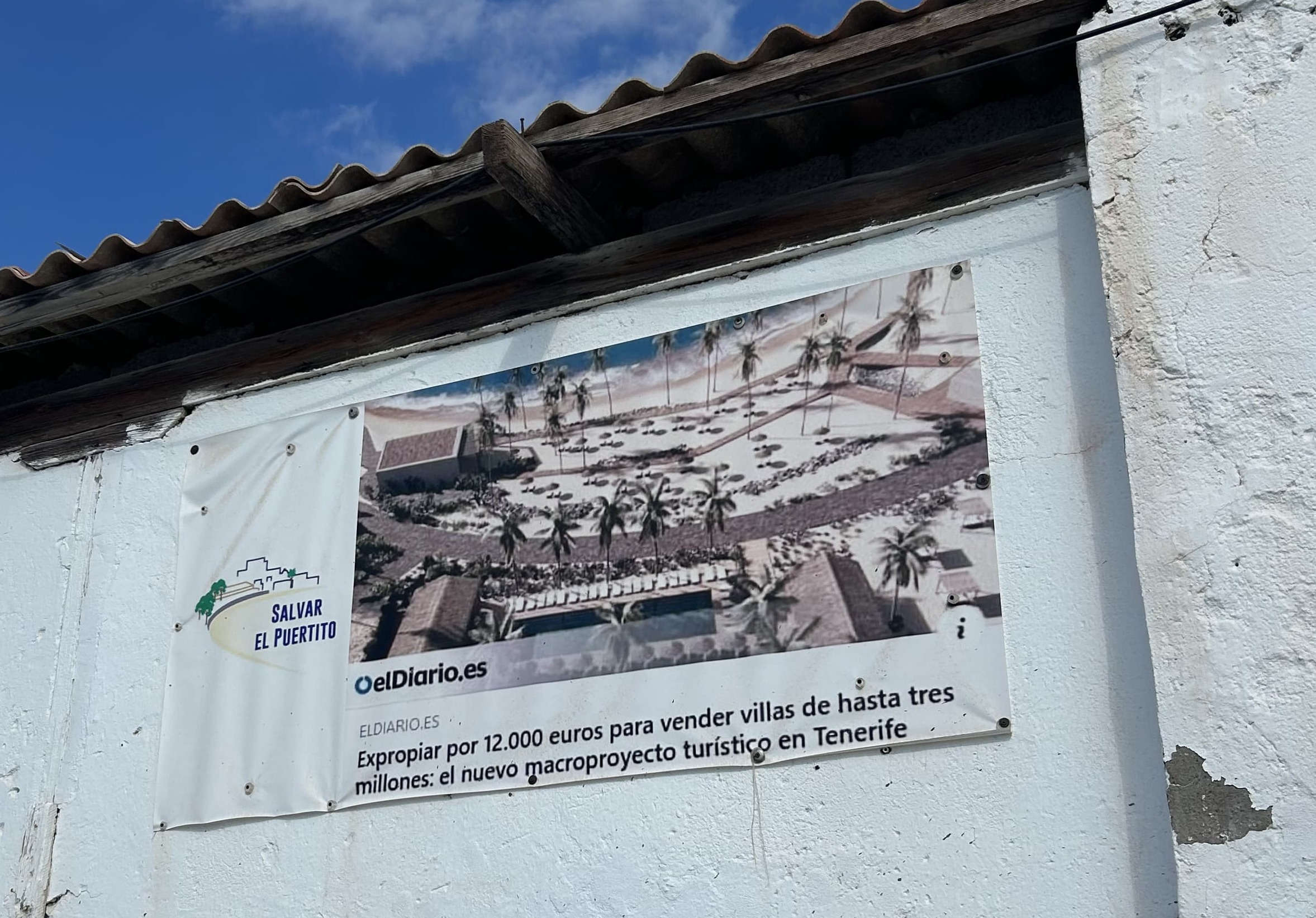
In early 2022, the Cuna del Alma project was announced. The complex is to be made up of hundreds of units of luxury villas, beach apartments, and houses with private terraces with pools and ocean views (Canarian Weekly, 2023).
Residents have expressed indignation that their land in El Puertito was expropriated from them for 12,000 euros and will be redeveloped into a luxury development with villas costing up to 3 Million euros each.
-
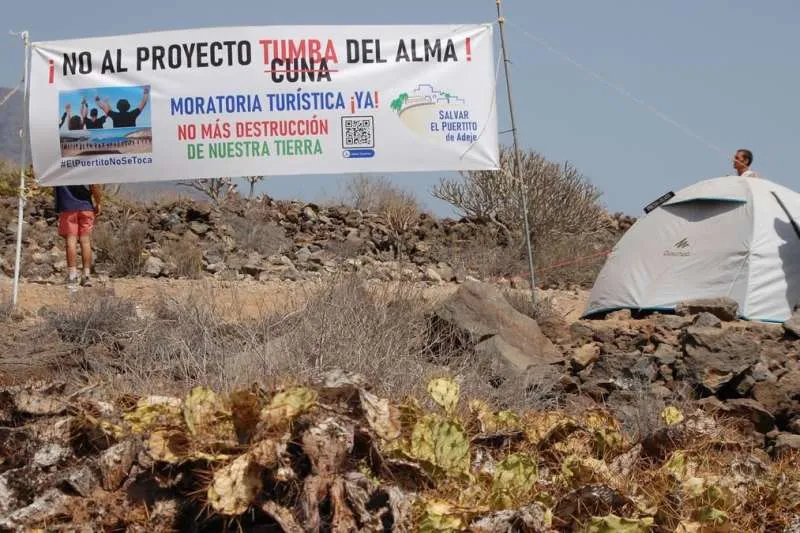
When construction started on the Cuna del Alma project in Puertito de Adeje in May 2022, demonstrations were organised against the development and protestors complained of violence and intimidation. The weeks of demonstrations and protests from locals and activists led to a moratorium on the project’s construction on August 20, 2022 (Canarian Weekly, 2023).
The project was found to be destroying specimens of Echium triste, featured in the catalogue of protected species. Construction was legally paused in October 2022 by an EU parliamentary decision (EU Parliament, 2022).
Photo credit Canarian Weekly (2023)
-
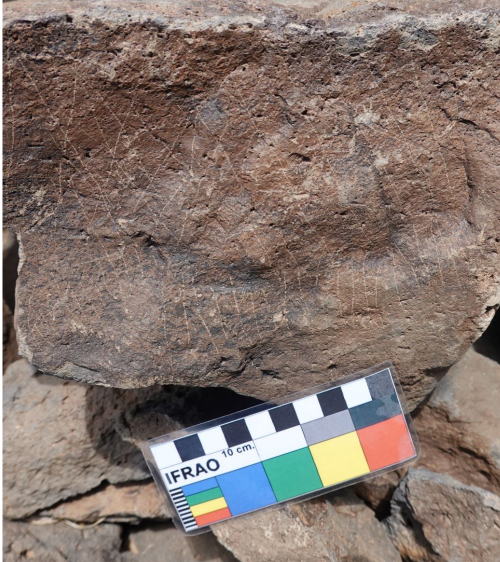
In December 2022, Marine Science Camp students as part of the GeoTenerife training programme began to document the coastal and marine environment, see here, and highlighted the need for further study. In 2023, our Marine Science Camp students have been carrying out an underwater survey of the marine environment which will published here shortly.
Furthermore, an archaeological study in the Puertito de Adeje area discovered cave markings and determined the site has “great potential” but has been damaged by the early stages of the Cuna del Alma construction (Atlanticohoy, 2023). Also, an old school building which was of significance to the local heritage of the area was destroyed and the rubble left visible on the ground.
- Vegetation: Native and endangered species within the Cardonal-tabaibal shrub community, and species of birds and invertebrates dependent on these plants for habitat.
- Geology: Volcanic deposits of large explosive eruptions: Fañabé and the Adeje eruptions which occurred around 1.5 Million years ago.
- Birds: The vast majority of the bird species observed at El Puertito are protected by local, national and EU laws including the Canary Islands Chiffchaff which breeds here and the the Little Egret which migrates here.
- Marine species: We observed a diverse marine environment with species of algae, sponges, fish (wrasse, Planehead filefish, parrotfish, and pufferfish), crabs, sea slugs, and the Azorean barnacle.
Learn more on the interactive map below
Photo credit Atlanticohoy (2023)
-

Construction was legally paused however our drone footage from January 2023 suggests evidence of new infrastructure and construction that were not present in 2022 satellite imaging. This implies some work may have continued on the Cuna del Alma project despite the restriction. Furthermore, in July 2023 the Superior Court of Justice of the Canary Islands rejected the Adeje City Council’s request for the suspension of the works to be lifted (El Diario, 2023), and by February 2024 the Canary Islands Government lifted the suspension allowing construction to continue on the site (Canarian Weekly)
-
On the 20th of April 2024, an unprecedented number of Canarian people took to the streets demonstrating against the unsustainable nature of the tourism model in the Canary Islands. Construction work on the Cuna del Alma resort continues whilst ten people are on hunger strike, demonstrating in support of a more sustainable tourism model in the Canary Islands. One of the more immediate demands of the protests on the 20th of April was the suspension of work on the Cuna del Alma project. In the weeks after the 20A demonstration protestors would block access to the site to prevent further “illegal” construction. Blow we feature social media posted by protestors and residents that were in El Puertito at this time.
Hoy en el Puertito de Adeje, están trabajando en Tumba de Alma, sobre la vivorina q ya no volverá a brotar con las lluvias. Y con nuestra gente en huelga de hambre y tras la movilización masiva del #20A.#CanariasTieneUnLimite #CanariasSeAgota pic.twitter.com/jCZ88BvneG
— María J. Belda (@MariaJBelda) April 22, 2024— Fernandito (@Fernand87580915) April 30, 2024
3D Models of the Environment
We invite you to explore this territory through our 3D digital models of the El Puertito area, which we have created with great enthusiasm in collaboration with Drones4Geology, and hosted freely with open access on the V3Geo site. For additional digital content regarding the area’s flora, fauna and geology, please refer to our interactive map and for more in-depth information on these aspects read our detailed report here.
Model 1 shows the unique record of ignimbrite deposits, lava flows, and fossilised beaches in Puertito de Adeje. Click on the image to access the 3D model.
Model 2 shows the submarine Ignimbrite deposits and lava flows in the Adeje Area. Click on the image below to access the 3D model.
Videos
We invite you to explore these videos of the El Puertito marine environment produced by the students and graduates of our training programmes.
What does the proposed Cuna del Alma hotel complex mean for the residents of Tenerife?
A resident of Tenerife, describes how the tourism industry has, and how the addition of the Cuna del Alma project to the island would affect them, video produced by Sergio Parra, GeoScholar 2023.
Drones4Geology launching an underwater drone to collect video footage of the marine life in El Puertito
Interview with Fernando Sabate regarding the Cuna del Alma in El Puertito
Fernando Sabate, Professor of Geography at Universidad La Laguna, Interviewed by Sergio Parra (GeoScholar 2022) regarding the Cuna del Alma project in El Puertito. [En Español]
An Environmental lawyer’s perspective on the Cuna del Alma project
Featuring Jaime Coello Founder of Canaria Telesforo Foundation Bravo Juan Coello, produced by Natalia Puche-Polo, VolcanoStories content collaborator.
Drone footage of El Puertito
Tamsin Backhouse, GeoTenerife’s in-house drone pilot expert took this footage of El Puertito showing the landscape where the Cuna del Alma project.
GeoTenerife interview with ITV about the Cuna del Alma project
Sharon Backhouse and Ignacio Garcia were interviewed by ITV regarding the Cuna del Alma project and sustainable tourism in Tenerife.
The Geological importance of Puertito de Adeje
This video was produced by Frankie Butler, a graduate of the GeoIntern 2023 scientific programme, and using GeoTenerife footage, talks about why the area of Puertito de Adeje is of great geological value
Interview with Pedro Dorta, regarding Cuna del Alma
Pedro Dorta, Head of Department, Disaster Risk Reduction and Resilient Cities, Universidad La Laguna, Interviewed by Sergio Parra (GeoScholar 2022).
Interactive map
We invite you to explore this interactive map of the El Puertito area which includes our geological, vegetation, and marine studies, which we have created from the data collected by the students of Marine Science Camp 2022 & 2023, and GeoIntern 2023. For additional information regarding the area’s flora, fauna and geology, please read our full report here.
Our Land-Use Proposal
The Cuna del Alma presents itself on its ‘Eco-manifesto page’ as environmentally sustainable and caring about protecting biodiversity. Our analysis of these claims finds that there lacks much evidence to support the claims made furthermore, our research of the vegetation, geology, habitats, and marine environment shows that the environment will be negatively affected by the Cuna del Alma project’s construction.
El Puertito has been designated as “Land Suitable for Planned Urban Development”, despite neighbouring the La Caleta Site of Scientific Interest and the Teno-Rasca Marine Special Area of Conservation. To maintain the conservation aims of the currently protected zones and preserve the identified unique geology, ecology, and archaeological features of El Puertito, we propose extending the La Caleta environmental protection zone to cover El Puertito and introduce a Cultural Protection Zone.
Our proposed changes to the land designations protect the unique ecology, geology, and archaeology found in El Puertito:
El Puertito has been designated as “Land Suitable for Planned Urban Development”, despite neighbouring the La Caleta Site of Scientific Interest and the Teno-Rasca Marine Special Area of Conservation. To maintain the conservation aims of the currently protected zones and to preserve the identified unique geology, ecology, and archaeological features of El Puertito we propose that the La Caleta environmental protection zone be extended to cover El Puertito and introduce a Cultural Protection Zone.
Land designations
- SRPC – Suelo Rústico de Protección Costera (Rustic Land for Coastal Protection)
- SRPH – Suelo Rústico de Protección Hídrica (Rustic Land for Hydrological Protection)
- SRPI – Suelo Rústico de Protección de Infraestructuras (Rustic Land for Infrastructure Protection)
- SRPP – Suelo Rústico de Protección Paisajística (Rustic Land for Landscape Protection)
- SRTP1 – Suelo Rústico de Protección Territorial Tipo 1 (Type 1 Rustic Land for Territorial Protection)
- SUBLESO – Suelo Urbanizable Ordenado (Land Suitable for Planned Urban Development)
- Cultural protection zone
The reasons behind our proposal are:
- Expanding the protected area to prevent construction from negatively impacting the neighbouring protected area.
- To preserve the ravines in Puertito de Adeje which are protected bird habitats.
- Protecting the geology on the coast of Puertito de Adeje to preserve information about Tenerife’s eruptive history is important to study to help build resilience for a possible future highly explosive volcanic event. These explosive deposits are unique and together with neighbouring La Caleta deposits are an open book record of 300,000 years of Tenerife’s volcanic history.
- Adding a new Cultural Protection zone to preserve one of the last true fishing towns of the south of the island and also the old packaging facilities for agriculture exports, part of the island’s heritage.
- Protect the rights of locals to one of the last remaining natural coastal areas they have enjoyed for generations.
- To encourage local planners and politicians to give greater weight to our natural landscapes and their significance for future generations.
- To promote a more sustainable and equitable tourism model to balance the needs of investors and residents in Tenerife
Our full report
To learn more about this research, read the report below.
Please share these resources freely with anyone interested in sustainable tourism in Tenerife. We would like to deeply thank our many collaborating researchers and the students of GeoIntern 2023, MarineScience Camp 2022 and MarineScience Camp 2023 without whom this report would not exist:
Editors: Natalia Puche Polo, VolcanoStories Collaborator, Bsc, Sergio Parra, student of Universidad La Laguna, and Ajay Wynne Jones, VolcanoStories Co-ordinator, MSci.
Collaborating Researchers: Dr Katy Chamberlain, Alexis Schwartz, Dr Steven Godby, Pablo Dávila Harris,
Collaborating Students: Silvia Paglia (University of Milano Bicocca), Laurence Lane (University of Leicester), Sergio Parra-Alfaya (Universidad de La Laguna), Francesca Butler (University of Bristol), Ryan Hill (Royal Holloway University of London), Leah Gingell (University of Hull), Bangran Tang (The University of California, Davis), Will Green (University of Plymouth), Marcus Chaknova (University of Oregon), Emma Hadré (Universität Kiel CAU), and Emma Badenas (University of Barcelona).

